Table salt won't work well for pickling because it contains additives that can ruin your preserved foods. The iodine and anti-caking agents in table salt create cloudy brines, produce off-putting metallic flavors, and can make your pickled vegetables become mushy instead of crisp. These additives also interfere with the natural fermentation process, potentially compromising food safety and preservation quality. You'll want to use pure pickling salt, which dissolves evenly and creates the perfect environment for beneficial bacteria to thrive. Understanding the right type of salt is just the first step to achieving pickle perfection.
Understanding Salt Crystal Structure
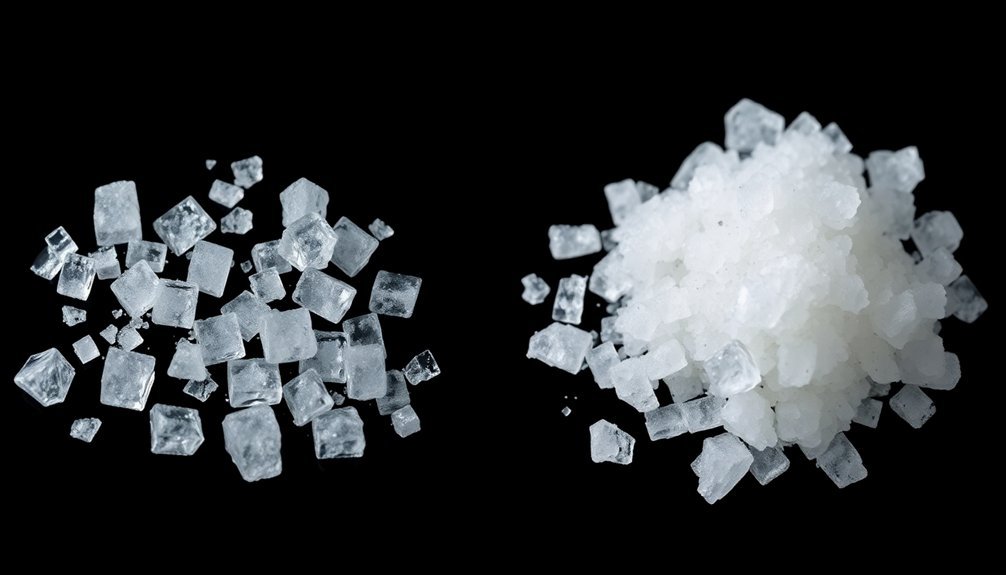
Anyone fascinated by pickling should understand the fundamental structure of salt crystals, as they're vital to the preservation process. When you examine table salt at the molecular level, you'll find an intricate arrangement of sodium and chloride ions held together by ionic bonds. These ions create a face-centered cubic lattice structure, where each sodium ion connects with six chloride ions, and vice versa.
The crystal structure forms through a precise organization of these ions, creating a repeating three-dimensional pattern. When you dissolve salt in water, these ionic bonds break, but they'll reform as the water evaporates. The environmental conditions during this reformation greatly impact the final crystal structure. Temperature, concentration, and humidity all play vital roles in determining how your salt crystals will develop. Slow evaporation rates typically produce larger, more uniform crystals.
Understanding this structure helps you recognize why table salt crystals aren't ideal for pickling. Their small, cubic shape results from rapid crystallization during commercial production. These tiny crystals dissolve too quickly and can create cloudy brine.
The crystal structure also influences how the salt interacts with your pickling solution, affecting both the preservation process and the final taste of your pickled foods.
The Problem With Iodine
Many home picklers avoid iodized salt due to misconceptions about its effects on the pickling process. The truth is, iodized salt won't affect your pickles' taste, color, or consistency. You can safely use it in both fermented and quick-pack pickling methods without compromising the final product. Studies have shown no significant differences in sensory characteristics between pickles made with iodized versus non-iodized salt.
However, you might notice some aesthetic differences when using iodized table salt. The anti-caking agents in the salt can cause:
- Cloudy brine that's less visually appealing
- Sediment formation at the bottom of your jars
- Slightly murky appearance in the final product
While these visual changes don't impact the pickle's flavor or safety, they're why many picklers opt for non-iodized salt.
It's worth noting that cloudy brine can also result from hard water minerals, which isn't related to iodine content.
If you're concerned about iodine intake, you don't need to avoid iodized salt in your pickling process. It's perfectly safe and won't interfere with fermentation or preservation.
The additives in iodized salt don't affect curing times, and you'll still need to follow proper sterilization and measurement procedures regardless of which salt you choose.
Anti-Caking Agents Impact Pickling Results
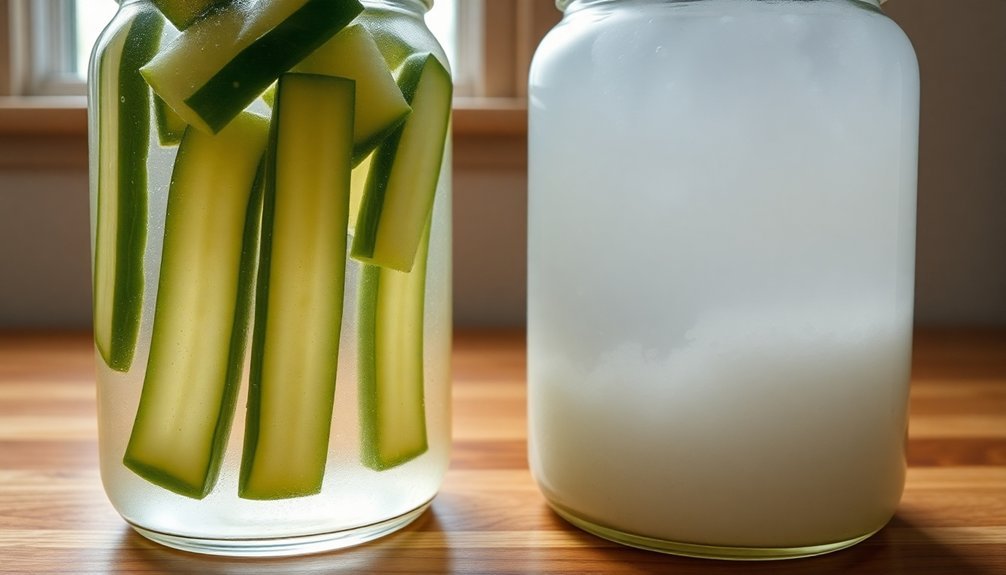
When you use table salt containing anti-caking agents in your pickling, you'll notice a cloudy brine that can make your pickles look unappetizing and potentially mask signs of spoilage.
These anti-caking additives don't dissolve in water, leading to sediment formation at the bottom of your pickling jars. Natural mineral content in some alternative salts can also contribute to cloudiness.
The undissolved agents can interfere with the preservation process, making it less stable and predictable than when using pure pickling salt.
Cloudy Brine Formation
Throughout the pickling process, anti-caking agents found in regular table salt can greatly impact your brine's clarity. When you use table salt for pickling, you'll notice that additives like iodine and anti-caking compounds create a cloudy appearance in your brine, making it difficult to monitor your pickles' condition.
These additives can also leave an unpleasant metallic or bitter taste in your finished product. While some cloudiness is natural during fermentation due to beneficial bacteria and yeast activity, additive-induced cloudiness is different and less desirable.
You'll want clear brine for proper visibility, especially when you're canning or monitoring the fermentation progress.
Here's what happens when you use table salt with additives:
- Anti-caking agents prevent the salt from dissolving properly, creating a hazy solution
- Iodine compounds react with vegetables, causing discoloration and off-flavors
- Mineral content from non-pickling salts leaves residue that clouds the brine
To achieve the best results, opt for pickling salt instead. It's specially formulated without additives, dissolves quickly, and maintains the clarity you need for successful pickling.
Unstable Preservation Process
Table salt's anti-caking agents pose significant risks to your pickling process, potentially compromising both safety and quality.
When you use table salt in pickling, these additives can interfere with the critical preservation mechanisms that keep your food safe. The chemicals can disrupt the proper balance of acidity and salt concentration needed to prevent harmful bacteria from growing.
You'll find that table salt additives can compromise your pickling results in several ways.
They'll interfere with moisture extraction, which is essential for creating an environment hostile to dangerous microorganisms. The additives can also react with other ingredients, potentially affecting the pH levels that are important for safe preservation.
As a result, you might end up with soft, slippery pickles that aren't properly preserved.
Clear Brine Versus Cloudy Solution
A jar of pickles can tell you a lot about its fermentation story through the appearance of its brine. If you're making fresh-pack pickles, you'll want a clear brine that indicates proper canning techniques and absence of unwanted bacterial growth. You'll achieve this by using pickling salt, soft water, and non-reactive cooking vessels.
However, when you're fermenting pickles, a cloudy solution isn't just normal—it's desirable. The cloudiness signals active fermentation and the presence of beneficial lactic acid bacteria that preserve your pickles and enhance their flavor. You'll notice this natural process developing when the temperature stays between 70-75°F.
For successful pickling, you'll need to understand these key visual indicators:
- Clear brine suggests either fresh-pack pickling or incomplete fermentation
- Cloudy brine indicates active fermentation and beneficial bacteria growth
- Settling cloudiness is normal and can collect at the bottom or top of the jar
While clear brine might look more appealing, don't be put off by cloudiness in fermented pickles. It's a sign that your fermentation process is working effectively, creating those tangy, probiotic-rich pickles you're aiming for.
Measuring Salt Concentrations Accurately
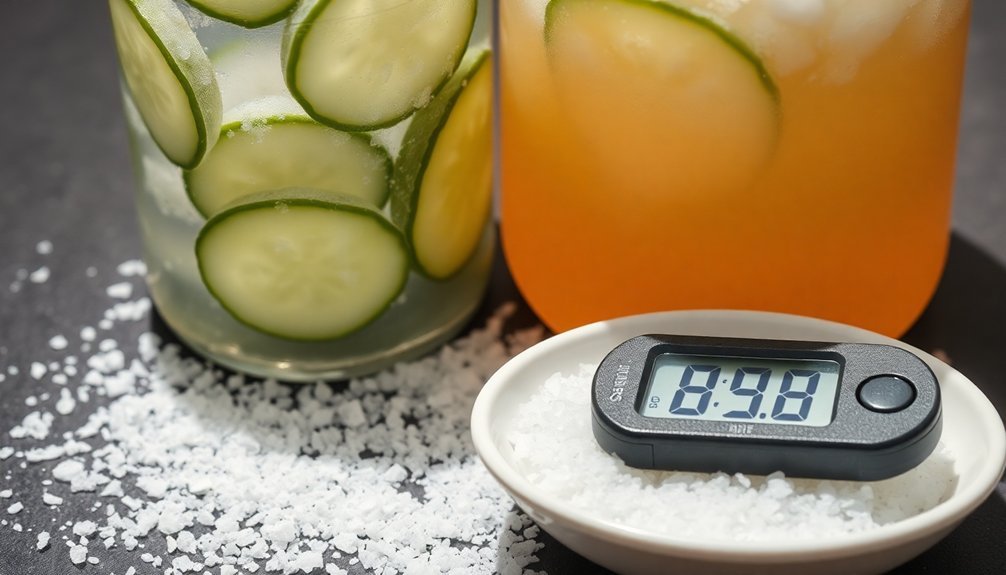
Before you begin pickling, measuring salt concentration accurately confirms consistent results and food safety.
You've got several reliable methods to choose from, each with its own advantages for home pickling.
You'll find that a hydrometer (also called a salometer) is one of the most practical tools for pickling.
It'll give you direct readings in pounds of salt per gallon or salt percentage by weight.
Just float it in your brine solution at 60°F, or use the temperature adjustment tables if needed.
If you're working with pure salt water, a refractometer can measure high concentrations between 10% and 28% without dilution.
You'll need to verify it's properly calibrated and used at the correct air temperature for accurate readings.
For the most precise measurements, you can use the electrical conductivity method.
You'll get readings in units like μS/cm or mS/cm, though other electrolytes in your pickling solution might affect the results.
While titanium electrodes are more durable, both gold and titanium options will work effectively for measuring your brine's salt concentration.
Salt Dissolution Rate Matters
When mixing your pickling brine, salt dissolution rate plays an important role in achieving consistent results. Table salt's anticaking agents don't dissolve in water, leading to cloudy brine and uneven salt distribution.
You'll notice these insoluble additives floating in your liquid, making your pickles less visually appealing and potentially affecting their marketability.
For ideal pickling results, you'll want salt that dissolves uniformly and completely. Fine-grain salts, like pickling salt, dissolve more readily than coarse table salt, ensuring consistent brine strength throughout your mixture. This uniformity is vital for proper fermentation and the development of safe, flavorful pickles.
Here's what happens when table salt doesn't dissolve properly:
- Uneven salt concentration creates inconsistent fermentation zones
- Floating anticaking agents make your brine cloudy and unappealing
- Variable salt levels can compromise pickle texture and safety
You can substitute pickling salt with fine sea salt or kosher salt, adjusting measurements accordingly. If you're working with coarse salt, consider grinding it finer before use. This extra step helps achieve the uniform dissolution needed for successful pickling.
Preserving Natural Food Flavors
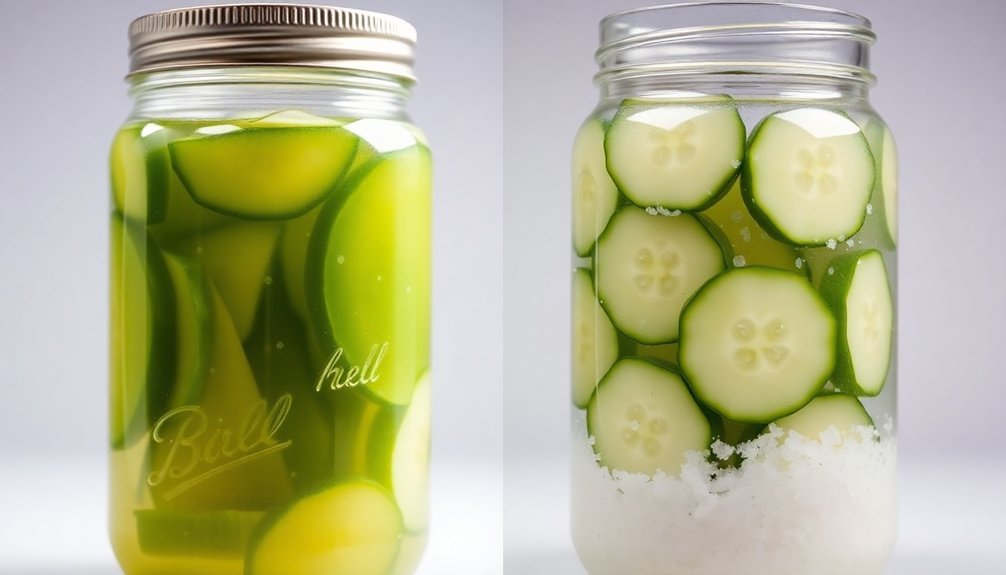
Pure pickling salt protects your food's natural flavors by eliminating unwanted chemical additives that can muddy the taste of your preserved items.
You'll notice a cleaner, more authentic flavor profile when using additive-free salt crystals, allowing the true essence of your vegetables and spices to shine through.
The pure salt crystals work to enhance the natural flavors of your ingredients while creating the perfect preservation environment, ensuring your pickled foods maintain their intended taste throughout storage.
Protective Pure Salt Benefits
The exceptional flavor-preserving qualities of protective pure salt make it an essential ingredient in pickling. When you're using pure salt, you'll create an ideal hypertonic environment that protects beneficial bacteria while eliminating harmful microorganisms. This selective process guarantees your pickled foods develop complex, natural flavors without unwanted microbial interference.
- Salt draws moisture from food through osmosis, concentrating natural flavors while maintaining the food's structural integrity.
- It creates an environment where beneficial lactic acid bacteria can thrive, leading to proper fermentation and flavor development.
- The salt barrier prevents aerobic bacteria growth, protecting your pickled foods from spoilage and off-flavors.
You'll find that pure salt's preservation capabilities extend beyond just protecting your food – it actively enhances the natural taste profiles of your pickled vegetables.
Additive-Free Taste Profile
Down through generations of pickling expertise, home canners have discovered that table crystals interfere with nature's intended flavors. When you use table salt containing iodine and anti-caking agents, you'll notice unwanted changes in your pickled foods' taste and appearance.
These additives can create off-flavors and cause your pickles to discolor, diminishing their natural appeal. You'll achieve better results by choosing pure canning or pickling salt instead.
Without additives, you'll preserve the authentic flavors of your vegetables while maintaining proper brine consistency. The absence of anti-caking agents means your salt will dissolve completely, creating a uniform brine that properly preserves your food.
When you stick to additive-free salt, you won't have to worry about white sediment forming in your pickling liquid or compromise the natural antimicrobial properties that make preservation possible.
Your pickles will maintain their crisp texture and intended flavor profile, just as nature intended. By following tested recipes that specify pure pickling salt, you'll guarantee your preserved foods retain their genuine taste while achieving the proper fermentation and preservation you're aiming for.
Natural Flavor Enhancement
With pure pickling salt as your foundation, you can focus on bringing out the vibrant natural flavors in your preserved foods. Unlike table salt's additives that can interfere with flavor compounds, pure pickling salt allows natural preservatives like ginger to work their magic.
You'll find that ginger's bioactive compounds, including shogaols and gingerols, enhance both taste and aroma while providing antimicrobial benefits.
To maximize flavor enhancement in your pickling, you'll want to:
- Use fresh, whole spices instead of ground varieties to prevent discoloration and achieve better flavor distribution.
- Combine ginger with complementary spices while following proper ratios to avoid overpowering or bitter tastes.
- Time your spice additions carefully during the boiling process to preserve their natural compounds and maximize preservation benefits.
Bacterial Growth Prevention
Preventing bacterial growth in your pickling process relies on four key factors working together: acidity, salt concentration, temperature control, and oxygen exclusion.
You'll need a highly acidic environment with a pH of 4.6 or lower to inhibit harmful bacteria. The acetic acid in your pickling brine disrupts bacterial homeostasis, while the acid produced by beneficial lactic acid bacteria helps control spoilage microbes.
Your salt concentration must be precisely balanced – enough to inhibit unwanted microorganisms but not so much that it prevents beneficial bacteria from thriving. When you use the right amount, lactic acid bacteria will outcompete harmful microbes, but excess salt can allow problematic yeasts to take over.
You'll want to maintain temperatures between 70-75°F for ideal fermentation. Higher temperatures can promote unwanted bacterial growth, while lower temperatures slow the process down.
Additionally, you must keep oxygen away from your pickling environment by keeping the brine covered. This creates anaerobic conditions that favor beneficial bacteria while preventing aerobic spoilage microbes from developing.
Without proper table salt's precise composition, you can't maintain these delicate balances needed for safe fermentation.
Recipe Success With Proper Salt
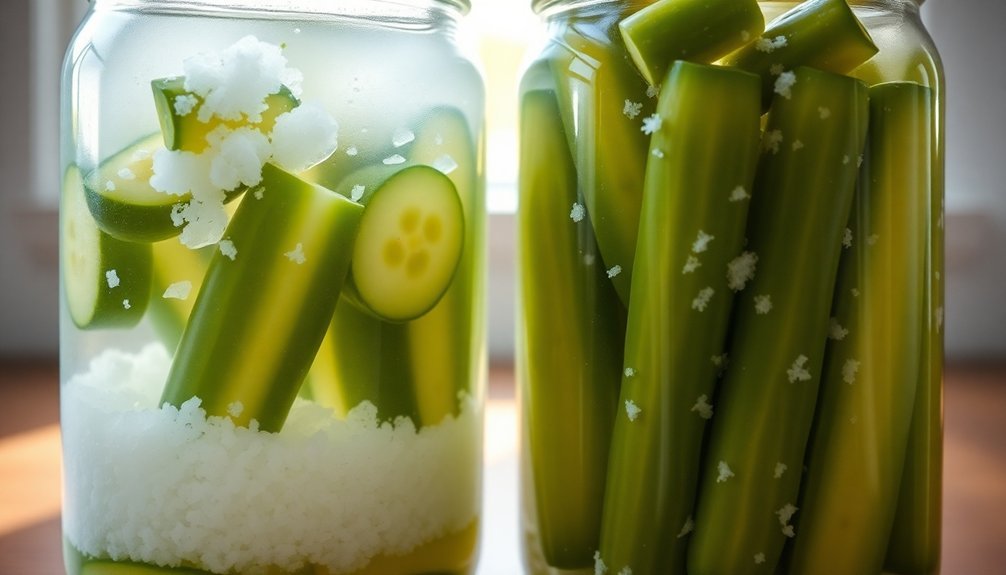
Successful pickling recipes consistently rely on using the right type of salt to achieve ideal results. When you use table salt instead of pickling salt, you'll find that your carefully crafted recipes can fall short of expectations due to inconsistent dissolution and uneven brine distribution. The additives in table salt, including iodine and anti-caking agents, interfere with both the taste and appearance of your pickled foods.
For your pickling success, consider these critical impacts of using proper pickling salt:
- You'll achieve crystal-clear brine that's visually appealing and indicates proper preservation, unlike the cloudy results you'll get with table salt's additives.
- Your pickled foods will maintain their natural flavors without the metallic or bitter undertones that iodized table salt introduces.
- You'll preserve the ideal crunch and texture of your vegetables, as pickling salt's fine, pure grains distribute evenly throughout the brine.
The consistency of your brine matters greatly, and pickling salt's quick dissolution guarantees uniform salinity throughout your mixture.
When you're investing time in preserving foods, using the right salt isn't just a suggestion—it's essential for achieving professional-quality results.
Frequently Asked Questions
Can I Mix Different Types of Salt for Pickling?
You shouldn't mix different types of salt for pickling. It'll create inconsistent results in your brine's concentration and affect flavor. Stick to pure pickling salt for the best, most reliable outcome.
How Long Can Pickles Last When Using the Wrong Salt?
When you've used the wrong salt, your pickles won't last as long – typically 2-3 months instead of 6-12 months. You'll notice faster spoilage, and they might develop off-flavors or become mushy earlier.
Does Pink Himalayan Salt Work for Pickling?
You shouldn't use pink Himalayan salt for pickling as its high mineral content and coarse texture can cloud your brine and affect flavor. It won't dissolve properly, and its minerals might impact your pickles' quality.
Can I Adjust Recipe Measurements When Substituting Table Salt?
You shouldn't substitute table salt for pickling due to its additives. If you must use alternatives, increase kosher salt by 1/4 or use equal weights. For sea salt, add 4 teaspoons per cup of required pickling salt.
Why Do Some Pickles Turn Mushy Despite Using Correct Salt?
Your pickles can turn mushy due to weak brine solutions, improper storage temperatures, overcooking, or using poor-quality cucumbers. You'll want to maintain temperatures between 70-75°F and avoid overprocessing during canning.
In Summary
You'll want to avoid table salt for pickling since its additives like iodine and anti-caking agents create cloudy brines and off-flavors. The crystal structure also dissolves differently than pickling salt, making it harder to measure accurately. Stick with pure pickling salt – it'll give you crystal-clear brines, proper fermentation, and the best flavor preservation in your pickled foods.

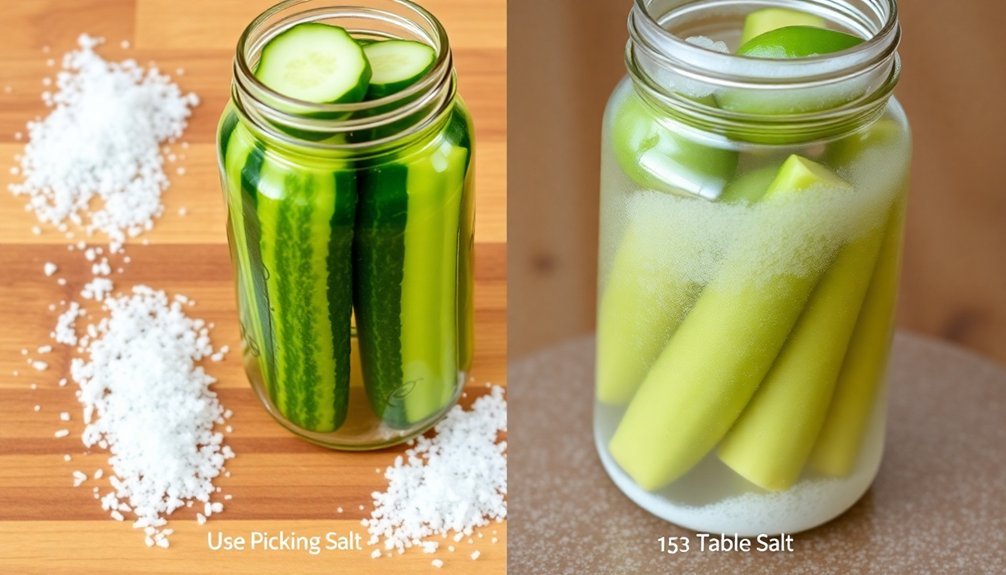



Leave a Reply